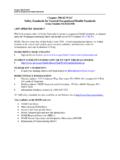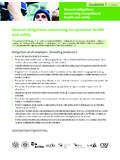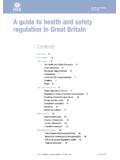Transcription of AT-A-GLANCE T Occupational Safety and Health …
1 RIGHTS ANDRESPONSIBILITIESE mployers must: Follow all relevant OSHA Safety and Health standards . Find and correct Safety and Health hazards. Inform employees about chemical hazardsthrough training, labels, alarms, color-coded systems, chemical information sheets and othermethods. As of January 1, 2015, notify OSHA within 8 hours of a workplace fatality or within 24 hoursof any work-related inpatient hospitalization, amputation or loss of an eye (1-800-321-OSHA[6742]); ). Provide required personal protective equipmentat no cost to workers.
2 * Keep accurate records of work-related injuriesand illnesses. Post OSHA citations, injury and illness summarydata, and the OSHA Job Safety and Health - It sThe Lawposter in the workplace where workerswill see them. Not retaliate against any worker for using theirrights under the law.* Employers must pay for most types of required personal protective have the right to: Working conditions that do not pose a risk of serious harm. Receive information and training (in a language workers can understand) about chemical andother hazards, methods to prevent harm, andOSHA standards that apply to their workplace.
3 Review records of work-related injuries and illnesses. Get copies of test results done to find andmeasure hazards in the workplace. File a complaint asking OSHA to inspect theirworkplace if they believe there is a serious hazard or that their employer is not followingOSHA rules. When requested, OSHA will keep allidentities confidential. Use their rights under the law without an employee is fired, demoted, transferred orretaliated against in any way for using their rightsunder the law, they can file a complaint withOSHA. This complaint must be filed within 30days of the alleged retaliation.
4 AT-A-GLANCEThe Occupational Safety and Health Act of 1970(OSH Act) was passed to prevent workers from being killed or seriously harmed at work. This law created the Occupational Safety and Health Administration (OSHA), whichsets and enforces protective workplace Safety and Health standards . OSHA also provides information, training, and assistance to employers and workers. Under the OSH Act, employers have the responsibility to provide a safe STANDARDSOSHA standards are rules that describe the methods employers are legally required to followto protect their workers from hazards.
5 BeforeOSHA can issue a standard, it must go through avery extensive and lengthy process that includessubstantial public engagement, notice and com-ment. The agency must show that a significantrisk to workers exists and that there are feasiblemeasures employers can take to protect , General Industry, Maritime, and Agriculture standards protect workers from a widerange of serious hazards. These standards limitthe amount of hazardous chemicals workers canbe exposed to, require the use of certain safepractices and equipment, and require employersto monitor certain workplace hazards.
6 Examples of OSHA standards include require-ments to provide fall protection, prevent trenchingcave-ins, prevent exposure to some infectious diseases, ensure the Safety of workers who enterconfined spaces, prevent exposure to such harmful substances as asbestos and lead, putguards on machines, provide respirators or othersafety equipment, and provide training for certaindangerous jobs. Employers must also comply with the GeneralDuty Clause of the OSH Act. This clause requiresemployers to keep their workplaces free of seriousrecognized hazards and is generally cited when nospecific OSHA standard applies to the are initiated without advance notice, conducted using on-site or telephone and facsim-ile investigations, performed by highly trainedcompliance officers, and based on the followingpriorities: Imminent danger.
7 Catastrophes fatalities or hospitalizations. Worker complaints and referrals. Targeted inspections particular hazards, highinjury rates. Follow-up inspections. On-site inspections can be triggered by a com-plaint from a current worker or their representativeif they believe there is a serious hazard or thattheir employer is not following OSHA standards or rules. Often the best and fastest way to get ahazard corrected is to notify your supervisor oremployer. When an inspector finds violations of OSHA standards or serious hazards, OSHA may issue citations and fines.
8 A citation includes methodsan employer may use to fix a problem and thedate by when the corrective actions must be have the right to contest any part ofthe citation, including whether a violation actuallyexists. Workers only have the right to challengethe deadline for when a problem must be of citations are heard by the independentOccupational Safety and Health Review FOREMPLOYERSOSHA offers free confidential advice. Several programs and services help employers identifyand correct job hazards as well as improve theirinjury and illness prevention programs.
9 Free On-Site ConsultationOSHA provides a free service, On-Site Consulta-tion, for small businesseswith fewer than 250workers at a site (and no more than 500 employ-ees nationwide). On-site Consultation services areseparate from enforcement and do not result inpenalties or citations. Each year, OSHA makesmore than 29,000 consultation visits to smallbusinesses to provide free compliance assis-tance. By working with the OSHA Consultation Program, certain exemplary employers may request participation in OSHA s Safety and Health Recognition Program, SHARP.
10 To locate the OSHA Consultation Office nearest you, or call 1-800-321-OSHA (6742).Compliance AssistanceOSHA has compliance assistance specialiststhroughout the nation who can provide general information about OSHA standards and compliance assistance resources. Contact yourlocal OSHA office for more information or ProgramsOSHA offers cooperative programs to help prevent fatalities, injuries, and illnesses in the workplace. Alliance Program OSHA works with groups committed to worker Safety and Health to developcompliance assistance resources and educateworkers and employers.















